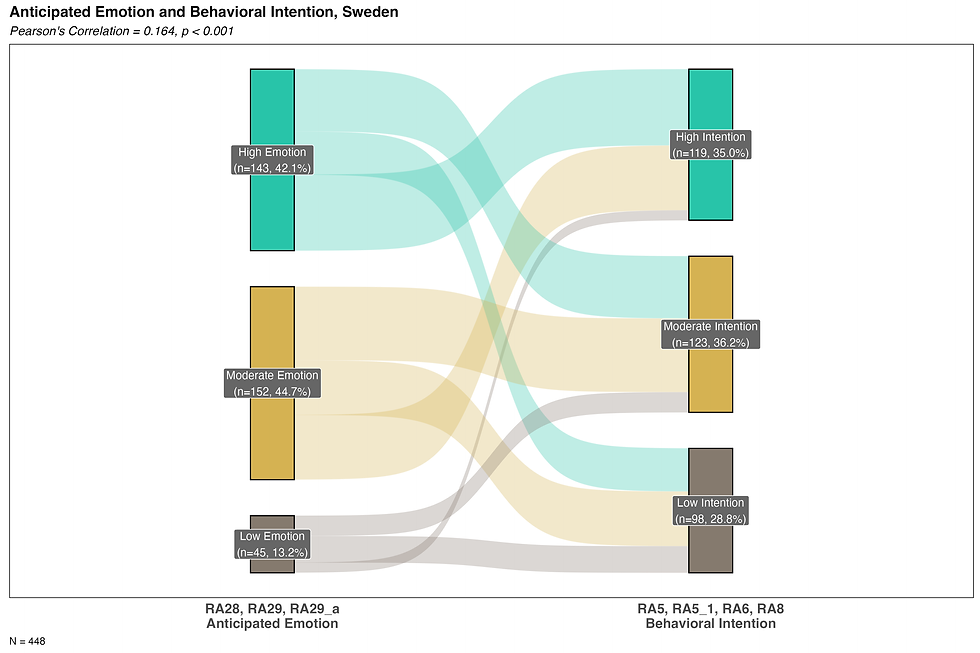
Findings for
Sweden
Cite as:
Perko T. (2025): RadoNorm European Radon Behavioural Atlas: Sweden, H2020 project RadoNorm, No 900009 https://www.radonorm.eu/
Methodology
Computer-assisted personal interviews (CAPI) were conducted in Sweden using an online panel provided by the marketing research company Kantar Public. The data were collected through the Sifo panel, the largest panel in Sweden, comprising over 100,000 active members. A random sampling approach was employed to obtain a sample as representative as possible of the adult population (aged 18 years and older), with respect to gender, age, and geographic region.
Sampling quotas were informed by expected response rates across socio-demographic groups. When specific groups were underrepresented, additional participants were recruited—within the limits of the panel—to meet the predefined quotas. A weighting variable reflecting the sampling quotas is included in the dataset to ensure representativeness.
Data collection began with a soft launch (N = 43) on June 22, 2023, followed by the main fieldwork, which was completed by June 27, 2023. The fieldwork was conducted by Kantar Public in accordance with the European Union’s General Data Protection Regulation (EU-GDPR) and the ESOMAR guidelines for market and social research.
The final sample comprised 1,046 respondents, resulting in a response rate of 15.4%. The average time to complete the questionnaire was 21.3 minutes.
The questionnaire was jointly developed by the RadoNorm project and the Swedish Radiation Safety Authority (SSM), which also funded the fieldwork and provided the Swedish translation. Data analysis was conducted by SCK CEN in Belgium.
It is important to note that, unlike other participating countries, the Swedish version of the questionnaire presented Likert-type agreement scales in the order from “strongly agree” to “strongly disagree.” To ensure consistency in cross-country comparison, the data included in the comparative dataset were reversed accordingly. The same reversal was applied in all associated data visualizations. However, the original ordering is preserved in the standalone Swedish dataset. Data are available at: DOI:10.20348/STOREDB/1179/1310
Download the questionnaire PDF here.
Download the technical report PDF here.
Results
Radon protection behaviour
Do people in Sweden test and mitigate?




Trustworthiness of radon stakeholders
Who in Sweden is recognized as a trustworthy source of information about radon risks?

Radon awareness
Are people in Sweden aware of radon?

Intention to protect from radon
What is the public willingness to adopt radon protection measures in Sweden?

Radon Knowledge
How much people in Sweden know about radon?


Risk perception
How do people in Sweden perceive radiological, radon and other risks?

Confidence in authorities for risk management
To what extent do Sweden have confidence in their authorities' ability to manage risks?

Truthfulness of radon stakeholders
Who in Sweden is recognized as a trustworthy source of information about radon risks?


Which stakeholders involved in radon mitigation in Sweden are recognized as technically competent?
Competence of radon stakeholders


Severity
What are people's beliefs regarding the seriousness of negative consequences due to radon?

Susceptibility
Do people in Sweden believe that radon increases the likelihood of health consequences?

Self-efficacy
Do residents in Sweden have confidence in their own ability to conduct radon testing and mitigation effectively?



Perceived behavioural control: financial and other burden and ease
Is radon testing and mitigation perceived as a financial or other burden?




Aesthetic impact of remediation works on a dwelling
Do residents believe that radon mitigation would visually harm their homes?

Social influence
What are the attitudes of respondents regarding social influence?

Anticipated emotions
What emotions do Swedes anticipate feeling if they do not take action against high indoor radon levels?

Economic impact of radon on a property value
Does a radon problem in a building negatively impact its financial value?

Moral values
To what extent do people agree with statements reflecting moral values?

Moral norms
To what extent do Swedes believe it is their moral duty to protect themselves and others from radon exposure?

Descriptive norms
Is radon testing and mitigation a common practice within social groups?

Subjective norms
Do family members and friends of resopondents care about radon-related issues?




Health effect perception
Do individuals have acquaintances who may have experienced health issues as a result of radon exposure?

Willingness to engage
How much are people willing to engage?

Information processing
How do people process information about radon?


Information comprehensiveness
Is there enough information readily accessible?

Information uncertainty

Is there too much uncertainty to make informed decisions?
Affective response to information
Does information related to radon elicit negative emotions?

Preference for post-survey radon-related information
Which communication channels are recommended for radon-related communication?

Factors Influencing Behavioural Intention
Radon awareness


Anticipated emotion

Risk perception


Confidence in authorities for risk management


Severity


Susceptibility


Response efficacy: remediation


Self efficacy



Perceived behavioural control: financial and other burden and ease



Perceived cost



Aesthetic impact of remediation works on a dwelling

Economic impact of radon on a property value

Subjective norms

Stigma

Moral norms

Moral values

Social influence

Health effect perception

Information uncertainty

Information processing



Information comprehensiveness

Affective response to information

Relationship Between Radon Awareness and Behavioural Intention to Act on Radon Risk

